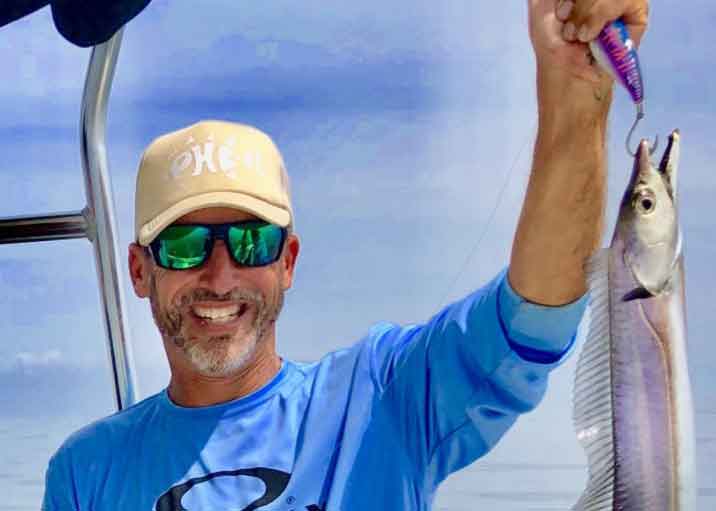Ribbonfish, otherwise known as cutlassfish, are a popular fishing target throughout the Atlantic, Pacific, and Indian oceans and have become a more common catch for those enjoying some Chesapeake Bay fishing in recent years. The fish is very popular in other countries throughout the world as they are delicious to eat and have been sold for up to 35 dollars a pound. The meat from the fish has been compared to flounder, is not fishy in flavor, and is light. In the Atlantic, ribbonfish can be found from Massachusetts to Argentina and the Gulf of Mexico. In the Bay they are most commonly found from the Patuxent river, south. When feeding, mature ribbonfish can be found near the surface during the daytime and in greater depths during the night time. Younger ribbonfish do not follow the patterns of mature fish and typically can be found in greater depths during the day and shallower depths during the night. Oftentimes, ribbonfish can be found in schools together throughout the region.

Members of the Trichiuridae family, ribbonfish can grow up to five feet long and can weigh up to six pounds. While they have been caught up to five feet in length, they are more often around three feet. Typically, ribbonfish can be mistaken for an eel as they are long in their appearance and swim like a snake. In addition, they have powerful teeth which prove helpful for hunting prey. As a result of their strong teeth and aggression, fishermen must take extra caution when going out on their adventure to catch ribbonfish as they can cause damage to lines.
Ribbonfish Identification
Ribbonfish can be identified by the following characteristics:
- Spear-shaped head
- Arrowlike teeth
- Silver coloring
- Low dorsal fin that extends through back
- Long and extended thin body
Ribbonfish Regulations
Maryland, Virginia and Delaware hold no size limit or bag limit and the season is open year-round. The lack of state regulations for ribbonfish throughout the region could possibly be tied to the fact that the species of fish is fairly new to the Chesapeake Bay region and has only recently become more of a popular fishing target.
Best Ribbonfish Baits
Fishermen throughout the region have had the best luck catching ribbonfish with:
- Minnow
- Squid chunks
- Fish chunks
- Shrimp
Popular Techniques for Ribbonfish Fishing
Differing from other fish throughout the Atlantic coast region, ribbonfish are not picky and fishermen have used many different techniques to catch the fish. Fishermen have found success with both casting and trolling lures like spoons and plugs, as well as fishing bait. Perhaps one of the biggest factors to keep in mind when fishing for these aggressive fish, which possess razor sharp teeth, is to have a trace of wire leader to eliminate the potential of the fish biting off the line.

A key tactic to catching the fish at night is having a light source close to the water. Due to this, some ribbonfish experts suggest connecting an underwater fluorescent night-light to the boat's battery with alligator clips. This light will produce a glow that will attract the fish. When attracting the school of fish, some fishermen also attach a small cyalume tube to the hook so that the fish can see the bait. Check out our article how to catch ribbonfish for more information on targeting this species both during daylight and at night.
Ribbonfish Fishing Tackle
Fishermen throughout the region suggest that it is best to use an eight- to 20-pound mainline. In addition, it is suggested to use a 30 to 40 pound monofilament leader attached to a 2/0 hook or your lure. Fishermen can ensure that their line is not bitten off by attaching a six-inch trace of number three wire.
Best Places to Fish for Ribbonfish
When setting out for your next adventure for ribbonfish, try to go at night as they primarily feed during the night hours. If one is seeking out bigger ribbonfish that have the potential to be a record-setting catch, it is important to go fishing in the ocean. Most of those found in the Bay are on the smaller side, and typically, bigger ribbonfish are found anywhere between two and 12 miles offshore. The fish can also be caught throughout the sandy bottoms of inlets and rivers that are connected to the bay. They can generally be located around structures and at night near light sources. Take a look at the most recent coastal fishing reports to see where the ribbonfish are running throughout the region.

While ribbonfish may not be a widely sought after fish throughout the country, they are nevertheless enjoyable to catch. On your next adventure out to the ocean or around the sandy bottoms or inlets connected to the bay, whether a beginner or an experienced fishermen, keep an eye out for ribbonfish – they will surely be looking to destroy your tackle, but will be worth the hassle once they are aboard the boat.
-By Devin Garner